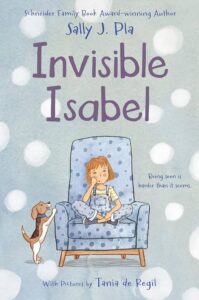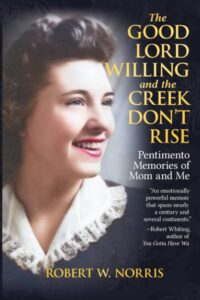Laila and Lucy are best friends intent on going to Sunderland Academy, an exclusive boarding school high school where Laila hoped to hone her baking skills and Lucy planned to learn more about investigative journalism. When a cookie baking competition comes up, it offers them both what they want: scholarships that will let their families afford the school.
The plan is for Laila to bake and Lucy to write about the competition. But when one of the judges collapses while eating Laila’s cookie, fingers point in her direction for foul play. As the girls become convinced that someone wanted the chef out of the way, they race to figure out who before someone else becomes a victim.
The Cookie Crumbles by Tracy Badua and Alechia Dow is a great middle-grade mystery that will have readers longing to munch on desserts while trying to figure out whodunnit. The authors tell the story with first-person accounts from the two main characters. As they dig deeper into what’s going on, they learn a lot about themselves, their fellow competitors, and even their own friendship.
The Cookie Crumbles offers just-the-right-amount of mystery for young readers to keep flipping pages while adding humor to a serious subject. I recommend it for ages 9 to 12.
The publisher provided a copy of this title in exchange for my honest review.
Isabel Beane lives in a house that’s hardly ever quiet. With five siblings and parents on the go, there’s always some hullabaloo. If anyone in her family stayed still long enough, she might tell them about the worry moths that flutter inside her, or the way the new girl at school has been mean to her and turned other girls against her.
Yet every time she tries, her words don’t come out loud enough to be heard. When she experiences an event in class one day, people finally slow down enough to listen. Can Isabel find her voice to make them understand how she feels?
Invisible Isabel by Sally J. Pla is a sweet tale about a neurodivergent girl who knows what she feels is real even when others tell her it’s all in her head. Isabel has quirks that others don’t understand and that sometimes make them feel uncomfortable. For instance, she hums or rocks to calm herself when she’s feeling overwhelmed.
The book is great at helping young readers see Isabel for who she is instead of the oddities she displays to help her cope with a busy life. The illustrations show Isabel in all her situations and appear in soft colors, which enhances the story.
I recommend it for readers aged 8 to 10.
The publisher provided a copy of this title in exchange for my honest review.
When Rue Matthiessen was eight, her family spent a summer in Ireland in an idyllic setting near the ruin of a castle. Her parents were going through a difficult period, but Rue remembers that time as a reprieve from the stresses causing a rift. Her parents, author Deborah Love and famed naturalist and writer Peter Matthiessen, continued to struggle with their relationship until Deborah died of cancer while Rue was in high school.
Decades later, with a husband and child of her own, Rue sets out to find the last place she remembers her family being happy together. She tells about her trip and faces truths about her parents and their flaws in her memoir, Castles & Ruins: Unraveling Family Mysteries & Literary Legacy in the Irish Countryside.
As her guide, Rue carries a copy of the book Deborah Love wrote about that summer, Annaghkeen. She intentionally seeks out some places her mother mentions and stumbles upon others. Through the lens of being a mother herself, she sees the actions of her parents in a new light.
Castles & Ruins is an interesting journey in two ways. There’s the physical meaning of Rue traveling around Ireland and discovering the landscape and people in a way she couldn’t as a child. There’s also a journey into her emotional past as she gains insights into the forces that compelled her parents to live the way they did. She’s open about their flaws as well as her own. Readers of memoir will appreciate her honesty while traveling with her through the book.
The publisher provided a copy of this title in exchange for my honest review.
When Farah Naz Rishi met Stephen while working on a class project in college, the last thing she thought is that they would become best friends and ultimately marry. For one thing, her first impression was that he was sloppy and inconsiderate. For another, she knew as a non-Muslim he would never be acceptable to her Pakistani American parents. But as she got to know him, a deep connection that turned into steady friendship grew. And over the years that connection became much more.
Rishi’s Memoir, Sorry For The Inconvenience, recounts how the relationship grew as well as gives insight into growing up in a family that is part of a close-knit community with high expectations for their children and how that affected those children. Rishi’s mother, in particular, was difficult to please and played an outsized role in how Rishi made decisions.
The memoir is at times painful to read, but Rishi’s voice is clear and honest as she recounts the struggles she goes through to find what she really wants from life and finds a way to be true to herself.
The publisher provided a copy of this title in exchange for my honest review.
Life is complicated for Kevin Lee. His single-mother mom always needs help at her alterations shop. His older sister is interested in life without her younger brother in tow. And his grandmother, recently arrived from China to live with his family, embarrasses him with her lack of English and strange ways.
Kevin also struggles to fit in at school, where others expect him to fit the stereotype of a typical Asian student. He wants to be seen and accepted for who he is, which is a kid who likes to draw comics, who misses his dad, and who wants time to just be a kid. A class trip to a local amusement park offers him the chance to be the hero of his own story. But will he be able to ditch the principal first?
Alterations by Ray Xu is a graphic novel set in the 1990s, when the author was growing up in Toronto. Kevin’s story draws on Xu’s own memories from childhood to capture the realities of middle school, particularly for children of immigrants. At turns funny, thoughtful and heartfelt, Alterations is great for readers aged 9 to 12.
The publisher provided a copy of this title in exchange for my honest review.
Else Bostelman was an artist who helped people understand what deep-sea creatures looked like by painting them underwater. The time was the 1930s, and world-renowned scientist William Beebe explored the waters off Bermuda, in the Atlantic Ocean. He hired Else to capture the images of things he discovered. Her adventures are told in a picture book by Jeanne Walker Harvey, Else B. In The Sea: The Woman Who Painted The Wonders Of The Deep.
Else descended underwater wearing a helmet that let her breathe as she worked. She developed a technique that actually let her paint what she saw with oils while below the surface, which helped her capture the way color changed as light from above grew dimmer.
Else also painted in her studio, recreating creatures that had been brought ashore. Her paintings, along with notes from Beebe, appeared in National Geographic magazine during the Great Depression.
Else B. In The Sea lets young readers discover more of Else’s exploits with an author’s note that talks about her life. Illustrations by Melodie Stacey have a dreamy quality that evokes the soft look of life underwater.
The author provided a copy of this title in exchange for my honest review.
Rachel and Joon are best friends out to solve a mystery: Did Anna Smith Strong, a purported spy during the Revolutionary War, leave clues to a treasure? If so, how can two kids figure out clues from more than two centuries ago? Spy Ring, by Sarah Beth Durst follows the two on an adventure of discovery where they find out about their own strengths as well as the history of their town.
Their hunt starts with the inscription on a ring passed down through Anna Smith Strong’s family. That leads them to her gravestone, which contains another clue. Working together, they follow a trail, deciphering clues along the way. The two sleuths have to work fast because Joon may have to move away from their hometown of Setauket on Long Island, New York.
Readers will love following along as the two bike around their town looking for answers. When they decide to trust a local historian and Rachel’s soon-to-be stepdad with the details of their quest, they find what they were looking for, even if it’s not what they expected.
Spy Ring is fun as a modern adventure as well as a historical look at how spies operated in the Revolutionary War. I recommend it for ages 9 to 12.
The author provided a copy of this title in exchange for my honest review.
While Robert Norris was growing up, his mother, Kay, set an example for him as an independent thinker. At a time when divorce was uncommon and looked down on, she got divorced. She stood up to the priest who refused her communion after she remarried. She worked hard throughout her life and wasn’t prone to complaining about whatever came her way.
Robert grew up to join the Air Force during the Vietnam War, then found he couldn’t support the military. As a conscientious objector, he was tried and spent time in a military prison. Afterward, he wandered through different cultures and countries trying to find a place he felt he belonged. That journey ended in Japan, where he found fulfilling work and met the woman who became his wife.
Robert tells his own tale as well as his mother’s story in the memoir, The Good Lord Willing and the Creek Don’t Rise: Pentimento Memories of Mom and Me. The tale shines a light on cultural norms during times of the not so distant past and the consequences paid by those who bucked them. Kay and Robert both show tenacity as they work their way through the challenges life serves up.
I would have preferred fewer small details of Robert’s home and work life and more of the emotional meaning behind his experiences, but all in all the tale is an interesting look at a mother and son who supported each other through good times and bad. To learn more about the author, you may want to check out his guest post on how his mother inspired in him a love of stories.
The author provided a copy of this title in exchange for my honest review.









